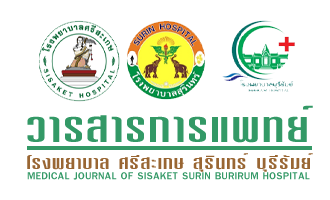ผู้ป่วยโรคไตเรื้อรังระยะสุดท้ายที่ได้รับการฟอกเลือด ระหว่างที่เข้ารักษาในโรงพยาบาลสุรินทร์
Main Article Content
บทคัดย่อ
เหตผลของการวิจัย: ผู้ป่วยโรคไตเรื้อรังระยะสุดท้ายอยู่ในภาวะ chronic intoxication จากอาการคั่ง ของของเสียในร่างกาย (uremic toxins) การบำบัดทดแทนไตด้วยวิธี การฟอก เลือดด้วยเครื่องไตเทียม จึงมีบทบาทสำคัญในการขจัดของเสียในร่างกายเหล่านี้ ทำให้ผู้ป่วยสามารถมีชีวิตยืนยาว ลดภาวะทุพโภชนาการและมีคุณภาพชีวิตที่ดีขึ้นได้ แต่ภาวะแทรกซ้อนระหว่างการฟอกเลือดด้วยเครื่องไตเทียมก็เป็นสิ่งที่แพทย์และ ทีมผู้ให้การดูแลผู้ป่วยต้องเข้าใจและสามารถแก้ไขอย่างถูกต้องและทันท่วงที เพื่อ ป้องกันอันตรายซึ่งถึงแก่ชีวิตระหว่างการรับรักษาด้วยการฟอกเลือดได้
วัตถุประสงค์: เพื่อศึกษาข้อมูลพื้นฐาน ภาวะโภชนาการ ภาวะสมดุลเกลือแร่ ข้อบ่งชี้และภาวะ แทรกซ้อนของการฟอกเลือดของผู้ป่วยโรคไตเรื้อรังระยะสุดท้าย (End stage renal disease, ESRD) ที่ได้รับการฟอกเลือดระหว่างที่เข้ารักษาในโรงพยาบาลสุรินทร์
วิธีการศึกษา: การวิจัยเชิงพรรณนาแบบย้อนหลัง
รูปแบบการวิจัย: รวบรวมข้อมูลผู้ป่วยที่ได้รับการวินิจฉัยว่าเป็นโรคไตเรื้อรัง (Chronic kidney disease) จากข้อมูลเวชระเบียนทีรับไว้รักษาในโรงพยาบาลสุรินทร์ ตั้งแต่ 1 มกราคม ถึง 31 ธันวาคม พ.ศ. 2550 วิเคราะห์ข้อมูลเชิงพรรณนาโดยใช้สถิติ จำนวนนับ ค่าร้อยละ และค่าเฉลี่ย
ผลการศึกษา: จากจำนวนผู้ป่วยโรคไตเรื้อรังระยะสุดท้าย (GFR < 15 มล./นาที/!.73 ม2) ที่ เข้ารับการรักษาในโรงพยาบาลสุรินทร์จำนวน 339 คน พบผู้ป่วยที่มีข้อบ่งชี้ในการ ฟอกเลือด 69 คน (ร้อยละ 20.35) ผู้ชายร้อยละ 55.07 อายุเฉลี่ย 58.9 ± 14.6 ปี ประเมินภาวะโภชนาการ พบว่า serum albumin 3.63 ± 0.72 g/dl Haemoglobin 9.38 ± 2.30 g/dl Hematocrit 27.58 ± 8.43 mg/dl ภาวะสมดุลเกลือแร่ของ ผู้ป่วยพบภาวะโซเดียมในเลือดต่ำ (130.36 ± 25.05 mmol/1) ภาวะโปแตสเซียม ในเลือดสูง (5.48 ± 0.87 mmol/1) ผลคูณของ calcium และ phosphorus > 55 mgVdl2 ร้อยละ 21.74% โดยข้อบ่งชี้ที่ทำให้ผู้ป่วยจะต้องได้รับการฟอกเลือด คือ ภาวะปัสสาวะบ่อย (Oliguria) ร้อยละ 25.51 เป็น และค่า serum creatinine มากกว่า 8 mg/dl ร้อยละ 24.32 อุบัติการณ์ของความดันโลหิตต่ำและความดัน โลหิตสูงขณะฟอกเลือดพบร้อยละ 9.76 และ 9.26 ตามลำดับ
สรุป: ผู้ป่วยโรคไตเรื้อรังระยะสุดท้าย (GFR < 15 มล./นาที/73 ม2) มีข้อบ่งชี้ใน การฟอกเลือดระหว่างรับรักษาในโรงพยาบาลร้อยละ 20.35 ซึ่งเกิดจากภาวะ แทรกซ้อนของโรคไตเรื้อรังระยะสุดท้าย ภาวะแทรกซ้อนของโรคไตระยะสุดท้าย คือ ภาวะซีด ภาวะ malnutrition และภาวะผิดปกติของสมดุลเกลือแร่ โดยข้อ บ่งชี้ที่ทำให้ผู้ป่วยจะต้องได้รับการฟอกเลือด คือ ภาวะปัสสาวะน้อย (Oliguria) และ serum creatinine มากกว่า 8 mg/dl ภาวะแทรกซ้อนระหว่างการฟอกเลือด ได้แก่ ความดันโลหิตต่ำและภาวะความคันโลหิตสูง ซึ่งแพทย์และทีมรักษาควรให้ ความสำคัญไม่ให้เกิดผลร้ายแรงกันผู้ป่วยได้
คำสำคัญ: โรคไตเรื้อรังระยะสุดท้าย, การฟอกเลือด, ข้อบ่งชี้, ภาวะแทรกช้อน
Article Details
เอกสารอ้างอิง
2. National Kidney Foundation Kidney Disease Outcomes Quality Initiative. Clinical practice guidelines for chronic kidney disease : evaluatioa classification, and stratification. Kidney disease outcome quality initiative. Am J Kidney Dis 2002;39:51-246.
3. National Kidney Foundation Kidney Disease Outcomes Quality Initiative. Clinical Practice Guidelines for Managing Dyslipidemias in Chronic Kidney Disease. Am J Kidney Dis 2003;41:S1- S56
4. Poggio ED. Wang X, Greene T et al. Performance of the modification of diet in renal disease and Cockcroft-Gault equations in the estimation of GFR in health and in chronic kidney disease. J Am Soc Nephrol 2005;16:459-66.
5. Cockcroft DW, Gault MH. Prediction fo creatinine clearance from serum creatinine. Nephron ; 1976:16:31-41.
6. อาภรณี ไชยาคำ. Chronic Renal Failure. ใน ตำราเภสัชบำบัด : Textbook of Pharmacotherpy. หน้า 339-342. กรุงเทพฯ : เฮลท์ ออทอริตี้ส์, 2546.
7. โศภณ นภาธร. Hemodialysis. กรุงเทพฯ : เท็กซ์ แอนด์ เจอร์นอล ; 2542.
8. Alfrey AC, Chan L. Chronic renal failure : Manifestations and pathogenesis In : Schrier RW, ed. Renal and electrolyte disorders. Boston : Little Brown and Co., 1992.
9. Manley, Harold J and Drayer Debra K et al. Medication-related problem type and appearance rate in ambulatory hemodialysis patients. BMC Nephrol 2003;10(4).
10. Collins AJ, Li S, St Peter WL, et al. Death, hospitalization, and economic associations among incident hemodialysis patients with hematocrit levels of 36-39%. J Am Soc Nephrol 2001;12:2465-73.
11. Block GA, Hulbert'Shearon TE, Levin NW et al. "Association of serum phosphorus and calcium X phosphate product with mortality risk in chronic hemodialysis patients : A national study," Am J Kidney Dis 1998;31:607-17.
12. Derwa A, Peeters P and Vanholder R. Calcium channel blockers in the prevention of end stage renal disease : a review. Acta Clin Belg 2004;59:44-56.
13. The Seventh Report of the Joint National Committee on Prevention Detection Evaluation and Treatment of High Blood Pressure. JAMA 2003;289:2560-72.
14. Chittinandana A Chailimpamontree พ, Chaloeiphap P. Prevalence of Chronic Kidney Disease in Thai Adult Population. J Med Assoc Thai 2006;89(2):S112-20.
15. Stevens LA, Coresh J, Greene T et al. Assessing kidney function-measured and estimated glonerular filtration rate. N Engl J Med 2006 ; 354(23):2473-83.
16. The Naional kidney Foundaion. NKF-K/DOQI Clinical practice guidelines for anemia of chronic kidney disease : update 2000. Am J Kidney Dis 2001;37:S182-238.
17. Tonelli M, Wiebe N, Culleton B et al. Chronic Kidney Disease and Mortality Risk : A Systematic Review. J Am Soc Nephrol 2006;31:1-14.
18. Vasavada N and Agarwal R. Role of excess volume in the pathophysiology of hypertension in chronic kidney disease. Kidney Int 2003;64:1772-9.
19. Vecchio LD, Pozzi M, Salvetti A et al Efficacy and tolerability of manidipine in the treatment of hypertension in patients with non-diabetic chronic kidney disease without glomerular disease. Prospective, randomized, double-blind study of parallel groups in comparison with enalapril. J Nephrol 2004;17:261-9.
20. Volume CI, Farris KB, Kassam R et al. "Pharmaceutical Care Research and Education Project : Patient Outcomes," J Am Pharm Assoc 2001;41(3):411-20.
21. Weiner ED, Tighiouart H, Amin MG et al. Chronic Kidney Disease as a Risk Factor form Cardiovascular Disease and All-Cause Mortality : A Pooled Analysis of Community-Based Studies. J Am Soc Nephrol 2004;15:1307-15.


